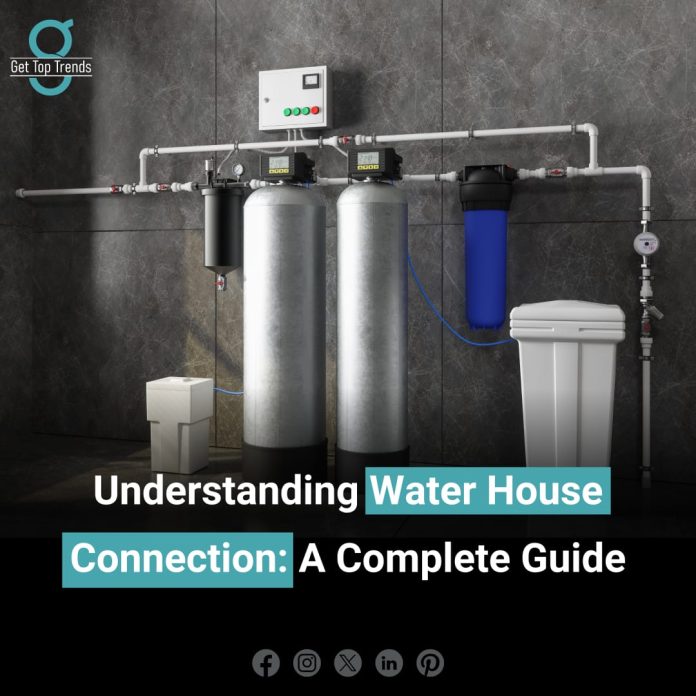We often take for granted having an ongoing water supply in our houses, even though it is necessary for our everyday survival. However, how does water get from your taps to the main supply? A water hose connection can be helpful in this situation. We’ll cover everything you need to know about water house connections in this article, ensuring you understand how it operates, how to maintain it, and why it’s crucial.
Think about it. You turn on your tap, but nothing happens. No water. It’s a major headache. This issue is prevented by a water house connection, keeping constant reliable water at your fingertips. Such knowledge is useful when constructing a new home or improving your existing setup. Grasping the concept of water house connections aids in making smart choices and dodging possible problems.
What is a Water House Connection?
The water house connection links your place to the town’s water source. It includes pipes, valves, and meters for a safe and smooth water flow to your home. It’s like the mainline funnelling water from the city’s reservoir into your home.
How Does a Water House Connection Work?
Your home gets water from a main line, often hidden under the ground. A service line transports the water from main. There are several parts that work together. These parts keep the water pressure and quality in good shape. So, when you twist the tap, clean water gushes out.
Types of Water House Connections
Direct Connection
With a direct connection, your home gets water directly from the main supply with any storage in between. This kind is the most seen connection in cities.
Indirect Connection
A storage tank is used in an indirect connection, providing a backup water source. This method is common in places with irregular water service or weak water pressure.
Components of a Water House Connection
Service Line
This line links the principal provision conduit to your home. Generally, it’s made of sturdy stuff like copper, PVC, or polyethylene.
Water Meter
Your water meter’s job is to track how much water your family uses. It helps calculate your bill and lets you keep an eye on water use.
Valves
Valves control the flow of water. The main shutoff valve is crucial for emergencies, allowing you to stop water flow to prevent flooding or damage.
Pressure Regulator
A pressure regulator acts like a guard. It keeps the water pressure going into your home safe and effective. This way, it protects your home’s plumbing system from harm.
Installation Process
Installing a water house connection involves several steps:
- Planning and Permits: Obtaining necessary permits and planning the connection route.
- Excavation: Digging trenches for the service line.
- Pipe Laying: Installing the service line and connecting it to the main supply.
- Meter Installation: Placing the water meter to measure usage.
- Testing and Inspection: Ensuring the system is leak-free and functioning properly.
Professional installation is recommended to comply with local regulations and ensure safety.
Maintenance Tips
Regular maintenance is key to ensuring a reliable water house connection. Here are some tips:
- Check for Leaks: Regularly inspect pipes and connections for leaks.
- Monitor Water Pressure: Ensure water pressure remains consistent and within safe limits.
- Clean Filters and Strainers: Regularly clean any filters to prevent blockages.
- Schedule Professional Inspections: Periodic inspections by professionals can help identify potential issues early.
The Importance of Professional Installation
While completing tasks alone might be satisfying, it’s best to outsource water house connection installation to the experts. They possess the knowledge to guarantee that the system is set up appropriately, safely, and by regional laws.
DIY vs. Professional Installation
DIY Installation
Even though some homes might try a do-it-yourself installation, it’s crucial to be aware of the risks. Low water pressure, leakage, and even pollution might result from improper installation.
Professional Installation
Expert installers have the know-how and resources to guarantee a reliable and secure connection. In addition, they manage permits and adhere to regional laws, offering comfort.
Conclusion
Getting water into your home means you need a water house connection. Figuring out what it’s made of, how to put it in, and how to keep it working can help you have a regular, safe water supply. This guide is here to help, whether you’re putting in a new connection or keeping up with an old one. Use this to help make smart decisions
FAQs
1.What is a water house connection?
It’s what links the city water supply to your house. It’s how the water you need flows .
2. How can I maintain my water house connection?
Regular checks for any leaks, keeping an eye on the water pressure, tidying up the filters, and getting a pro to inspect it now and then.
3. What are common issues with water house connections?
Well, things like low water pressure, leaks, and sometimes, no water! Regular upkeep and expert inspections help stop these issues from sneaking up on you.
4. Should I install my water house connection myself?
Better not to. Hiring a skilled pro ensures everything’s safe, meets rules and works right.
5.How do I choose the right service provider for my water house connection?
Check their experience, read up on reviews, and look at their license and pricing. Compare a few before you make up your mind.




